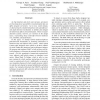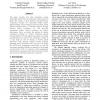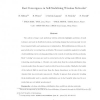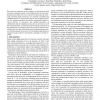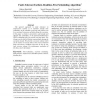109
Voted
DFT
2003
IEEE
15 years 5 months ago
2003
IEEE
Transient faults in VLSI circuits could lead to disastrous consequences. With technology scaling, circuits are becoming increasingly vulnerable to transient faults. This papers pr...
78
Voted
ISCA
2005
IEEE
15 years 6 months ago
2005
IEEE
As chip densities and clock rates increase, processors are becoming more susceptible to transient faults that can affect program correctness. Up to now, system designers have prim...
HICSS
2005
IEEE
15 years 6 months ago
2005
IEEE
This paper presents how state consistency among distributed control nodes is maintained in the presence of faults. We analyze a fault tolerant semi-synchronous architecture concep...
107
click to vote
DATE
2005
IEEE
15 years 6 months ago
2005
IEEE
In this paper we present an approach to the design optimization of faulttolerant embedded systems for safety-critical applications. Processes are statically scheduled and communic...
118
Voted
SBCCI
2006
ACM
15 years 6 months ago
2006
ACM
This work describes a hardware approach for the concurrent fault detection and error correction in a cryptographic core. It has been shown in the literature that transient faults ...
112
click to vote
IPPS
2006
IEEE
15 years 6 months ago
2006
IEEE
The performance requirements for contemporary microprocessors are increasing as rapidly as their number of applications grows. By accelerating the clock, performance can be gained...
120
click to vote
ICPADS
2006
IEEE
15 years 6 months ago
2006
IEEE
The advent of large scale multi-hop wireless networks highlights problems of fault tolerance and scale in distributed system, motivating designs that autonomously recover from tra...
112
Voted
DELTA
2006
IEEE
15 years 6 months ago
2006
IEEE
We present an approach to the synthesis of fault-tolerant hard real-time systems for safety-critical applications. We use checkpointing with rollback recovery and active replicati...
105
Voted
IPPS
2007
IEEE
15 years 6 months ago
2007
IEEE
The general approach to fault tolerance in uniprocessor systems is to maintain enough time redundancy in the schedule so that any task instance can be re-executed in presence of f...
DSN
2007
IEEE
15 years 7 months ago
2007
IEEE
A new approach is proposed that exploits repetition inherent in programs to provide low-overhead transient fault protection in a processor. Programs repeatedly execute the same in...

